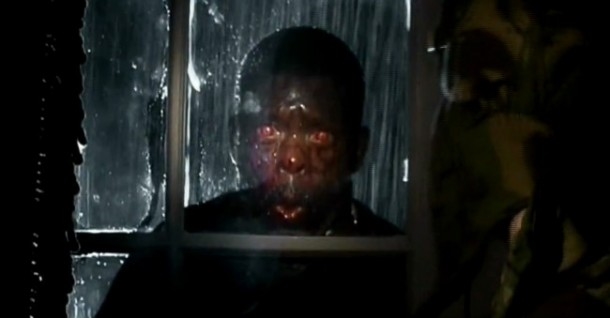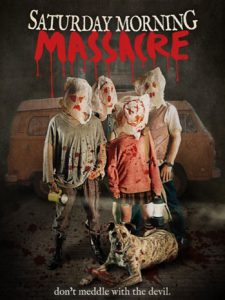
10 Horror Movie Diseases That Will Kill You Dead!
Somewhere between the Midwest and the Eastern Seaboard, there’s a current plague going around. No, it’s not the one you’ve been waiting for, so put your Daryl Dixon-loving crossbow back on the shelf. It’s just the common flu.
Perhaps you or someone you know is suffering from the aforementioned pestilence. If so, then it’s a perfect time for an illness-themed movie fest to assuage your woes. Your chills and general malaise won’t seem so bad compared to extra-potent rabies and all-pervading insanity. And although I’m writing this article from Pittsburgh, the official Zombie Capital of America, the movies on this list are not dedicated exclusively to reanimating viruses, even if a few brain-munchers do make the cut.
So in honor of the general plagues among us, here’s a smattering of unusual and almost universally terminal conditions brought to us by the genre we love.
Rage Virus in 28 Days Later
Are they zombies, or are they simply maniacs? Many horror fans have engaged in the more than decade-old debate about the nature of Danny Boyle’s 2002 entry in the horror catalog. Can something truly earn the undead moniker if it never died?
At times deliberately paced and pervasively moody, 28 Days Later set a new and unusual standard that pits it somewhere between all-out gorefest and glorious art house indie. As filmgoers, we learned that when PETA-esque activists go up against major scientists, the whole world loses—or at least all of England does. As proven time and again in sci-fi and horror, the military is quick to go rogue, even managing to turn a future Dr. Who into a rape-lusting general.
So again we ask: fast-moving zombies or viral-induced lunatics? In a world like that, does it really matter? Nope, probably not.

“Trixie” in The Crazies
Though not the most famous infection film from George Romero’s oeuvre, 1973’s The Crazies along with its forgettable 2010 remake introduced horror audiences to Trixie, the code name for a bioweapon accidentally released by none other than the good ol’ military. Symptoms include permanent psychosis. You can imagine the one-word government press release: Oops.
Perhaps it’s the inherent anarchist in me, but something along the lines of Trixie is the number where I’d place my bet for the start of the apocalypse. Ham-handed schemes are routine pastimes for power-mad regimes the world over. And in America, where Congress can’t balance a budget with money that isn’t even really theirs, how far do we have to stretch reality to buy that some lackadaisical higher-up could make a random mistake—be it an airplane malfunction or just a clerical error—and condemn us all to death? Maybe the population won’t go irrevocably insane, but a government that’s got your personal email on its reading list seems neither trustworthy nor apologetic. And that’s scarier than ten counties of stampeding townsfolk.

Rabies in Cujo
Nobody said a scary horror movie disease had to be fictitious. In fact, the titular fido’s metamorphosis from friendly canine to man’s worst mouth-frothing enemy is unnerving precisely because it’s real—or at least could be. Any effective terror, however, is diminished once the audience has to endure what seems like hours hanging out in a freakin’ Pinto. Of course, the car’s alternator died. The mother-son duo should just be grateful that the lemon didn’t blow up with them still inside, taking the Saint Bernard out as collateral damage.
Cujo’s love-it-or-hate-it vibe is cemented with the casting of Dee Wallace. A great actress no doubt, but a mere two years earlier in The Howling, she faced a resort filled with werewolves, the venerable big brothers to rabid dogs everywhere, and she managed to escape, albeit with a nasty scrape. Somehow, one mad dog seems like infectious peanuts by comparison.

Vampirism in Near Dark
Logic dictates if a condition can be cured with a medical intervention, then it can be fairly classified as a disease. And that’s exactly what happens with vampirism in Kathryn Bigelow’s 1987 tour de force.
Granted, the third-act cure is the hokiest part of an otherwise raucous vampire western, a subgenre that never followed through on its potential. But even if you rightfully believe that there’s no coherent way to drain every single drop of vampire blood out of lead cuties Caleb and Mae, you sort of forgive their implausible trespasses in favor of a vampire movie voted by readers as the third best on this very site. Blood transfusions may be silly, but in a world of Byronic baddies and sparkly fangs, a truly good vampire flick is nothing to scoff at.

Necrotizing fasciitis in Cabin Fever
Don’t worry, this isn’t going to turn into a lame science lesson. Necrotizing fasciitis is just the fancy term for flesh-eating disease. And while the real-life ailment afflicts victims post haste, the strain in Eli Roth’s 2002 Cabin Fever is even more virulent, sort of like rot on steroids.
Taking a page from The Crazies before it, Cabin Fever puts forth the thesis that tainted water supplies will destroy all your fun. In this case, a spring break filled with harmonious premarital sex turns into a total dud when five college kids pick a cabin locale as equally cursed as the one with that tape recorder that raises the dead. Unfortunately, everything from random vicious dogs (Cujo lives!) to racial slurs masquerading as jokes interrupt the decomp fest, but a few moments, including the infamous bathtub scene, endure in our hypochondriac psyches as a reminder not to drink the water. Pass the bottled Aquafina, please.

Demonic possession virus/mutated rabies in REC/Quarantine
Converting a foreign horror film into an English-language adaptation is often wrought with lost in translation misery. And while Quarantine retains much of REC’s story, the Spanish film’s virus digs down to the heart of religion and the hypocrisy that exists among those who claim devoutness. The powers-that-be, however, deemed American audiences far too dull to understand all that subtext, so the filmmakers just used the default and went with rabies. Because when in doubt, rabies is apparently a great stand-in for spiritual nuance.
If you are indeed ill and your endurance or lack thereof forces you to choose between the two, eschew the remake and opt for the original. Unless you’re fluent in Spanish, you’ll have to read subtitles, but it’s a small price to pay for genuine scares rather than Hollywood backwash.

The T-Virus in Resident Evil
If there was a beauty contest among fictional diseases, then the T-Virus’s cerulean DNA in a jar would definitely win the title. And if there was a relay race to see which horror movie disease wreaks havoc the quickest, heck, it might be a contender for that too. Toss one vial down in a lobby and watch as life as you know it ends abruptly!
Even if you agree that the never-ending sequels have produced diminishing returns, it’s always worth the tolls to travel back to Raccoon City where it all began. From zombie dogs to Milla in that little red dress, the debut film in the series still makes for a rollicking good time.

Merrye Syndrome in Spider Baby
Perhaps the most tangential of the ten conditions, Spider Baby’s Merrye Syndrome is a genetic malady that causes members of the afflicted family to evolutionarily backpedal into complete savagery. If this film’s version of Darwinism is to be believed, cavemen were a totally rowdy bunch.
With a darkly comedic tone and luscious cinematography, the horrors and even the tragedy of the vicious Merrye clan prove effectively creepy a half century later. Frequently noted for its performance by a young Sid Haig, this oft forgotten gem is a strange brew of inbreeding, arachnids, and Lon Chaney, Jr. The mid-1960s are sometimes remembered as a rather staid era of horror, but the film’s three maniac children—along with a few truly inhuman descendents in the basement—will remind you otherwise. Even the Addams Family refuse to visit this bunch.

Unknown Cause in Romero’s Dead series
In some ways, this entry might not belong on the list. Blasphemy, I know, but as an audience member, we never learn what virus, bacteria, or other point of origin causes the zombie plague. Some characters in the series even conjecture that an alien virus or heavenly castigation is responsible. And though the zombie button is clearly passed through bites, a person can die and reanimate without any obvious sign of infection.
However, without the progenitors of the zombie craze, this list simply wouldn’t feel complete. Like the undead themselves, Night, Dawn, or Day always persevere. Several decades and a substandard trilogy later, and those original zombies still shamble through our horror-loving hearts, whether they’re the product of infection, aliens, or hell itself.

Plague virus in The Last Man on Earth/ The Omega Man/ I Am Legend
Poor Richard Matheson. Despite three tries, Hollywood just can’t get his 1954 masterpiece right.
Maybe the failures are due in part to the intricacy of the story. Even in the novel, the virus’s results are almost difficult to define. Many consider the creatures in the book—and by distant proxy, the unfaithful films—to be most closely akin to vampires. But since George Romero himself credited I Am Legend as inspiration for Bub et al, perhaps the monsters should be christened as some kind of unusual hybridization of the two species.
But any awesome subtlety is lost on filmgoers. Each adaptation diverges further from the spirit of the source material, which at this rate, means the fourth version will be a romantic comedy starring Reese Witherspoon. Let’s just assume that a real zombie plague will kill us all before that. Did I say assume? I meant hope.

Let me know your favorite horror movie disease in the comments below!




![Best Indie Horror Films [ Part 2 ]](https://www.horror-movies.ca/wp-content/uploads/2021/04/absentia-610x343-2-300x169.jpg)









